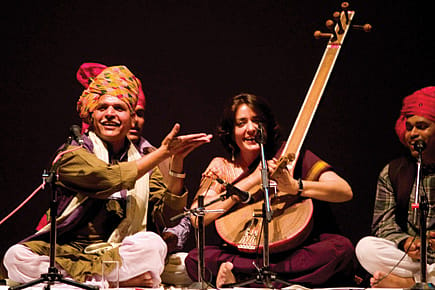Mystic Movement

After the dark days of the Gujarat riots, there came a glimmer in Shabnam Virmani's discovery of the diverse social landscape that the poet Kabir still inhabits.
I did'nt choose Kabir, Kabir chose me!" says filmmaker Shabnam Virmani each time she is asked why she decided to make a documentary series on the mystic poet. Her quest for Kabir began in 2002, when the Gujarat riots took place. She was living in Ahmedabad at the time and the heinous acts of violence that she bore witness to drove her on a quest to understand what made human beings capable of so much violence and hatred.
"Kabir's poetry began to speak to me very powerfully. He began to show me the working of our mind, how we all pin our identities on the construction of very insecure egos, which we then begin to defend through dishonesty and violence, subtle or gross, interpersonal or intercommunity or inter-nation," says Shabnam. This revelation inspired her to conceptualise The Kabir Project, which started as an in-residency programme at the Srishti School of Art, Design and Technology in Bangalore, supported by the Delhi-based Ford Foundation. So intense has been the experience that she has now been invited to speak on the subject at the TEDx Delhi Summit, scheduled to be held this August in New Delhi.
2025 In Review
12 Dec 2025 - Vol 04 | Issue 51
Words and scenes in retrospect
In 2003, Shabnam embarked on a series of journeys through the socio-cultural and spiritual landscape of Kabir. As she travelled around the country with camera in hand, she met people who had tried to instill meaning into their lives through Kabir's poetry. The six-year-long quest resulted in four documentary films, ten audio CDs and poetry books, all extolling the vivid diversity of the cultural and religious traditions that the poet inhabits.
Not one to rest on past laurels, Shabnam and her team have already begun work on the next phase of the project—to make the material more dynamic and interactive. "We are trying to construct a web duniya of Kabir's songs and poetry, where you could search or explore the songs, conversations about poetry, different musical renditions of the same poem, get translations and access to lyrics along with research references to the poetry," she says.
The team is also exploring ways and means to bring the power of live folk music into the classroom, so that students are given the opportunity of listening to Kabir rather than just reading him. "Another area of work is to plough back the proceeds from sales of films, CDs and books towards supporting village-level satsangs and folk-singing traditions," says Shabnam.
The first step towards this was taken in March this year, when the ten-day-long Malwa Kabir Yatra brought together folk singers from Rajasthan, Gujarat and Kutch for eight village concerts in Madhya Pradesh. This was a unique departure from usual city concerts that take place far removed from the traditional or cultural context of the performance.
While the project has received critical acclaim and success, it is the lifelong friendships forged with singers, scholars, activists and students that the team members hold closest to their hearts. In fact, the deep bond shared by folk singers like Prahlad Tipanya, Mukhtiyar Ali, singer Vidya Rao and scholars like Linda Hess and Purushottam Agrawal has become the soul force behind the project. It is their combined experiences and ideas that have nudged the four documentary films into existence.
The first one, titled Had Anhad: Journeys with Ram and Kabir, takes a closer look at the divides created by regionalism and nationalism. Koi Sunta Hai: Journeys with Kumar and Kabir examines the boundaries that are created in the realms of knowledge, art and music, while the third film, Chalo Hamara Des: Journeys with Kabir and Friends, explores the cross-cultural friendship between rural folk singer Prahlad Tipanya and American scholar Linda Hess. Shabnam's experiences in a Damakheda village in Chhattisgarh form the basis for the fourth film, Kabira Khada Bazaar Mein: Journeys with Sacred and Secular Kabir. She chronicles a man torn between the opposing pulls of the individual and the collective, the spiritual and the social.
The spontaneity of each film is heartwarming to behold. Nothing was pre-planned; Shabnam simply set out on an instinct and with no pre-determined script in her mind. "I kept following interesting leads. Sometimes, they yielded nothing, but sometimes beautiful moments would just happen and you had to be ready with your camera to respond to them," she says.
For Shabnam, the project has been a deeply transforming experience. Each moment of the journey brought her closer to the fissures in her own mind; the dualistic way of perceiving herself and the world. Those experiences made her realise that these films were not creations that she had chosen or made; rather, these were gifts that she had received from a space that she could not claim to completely comprehend. "Over the years, the meaning of Kabir and his teachings have undergone a change for me. I think knowing Kabir more deeply is a process of knowing yourself more deeply. And so, in that sense, Kabir continues to speak to me on a day-to-day basis because knowing yourself and your location in the world is an endless quest, isn't it?" she says.
